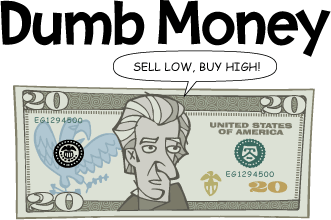

Nobody really knows when or where money was first coined, but you can be sure misusing, abusing, and misunderstanding it followed soon enough. And continues to this day. Which is understandable because even though businesses and economists can run the numbers there’s a lot more to it than simple arithmetic. Still, there are some ideas that hang on like a bad cold even though they are easily shown to be erroneous.
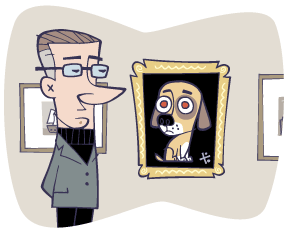
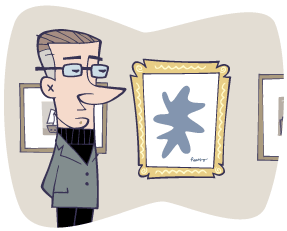

The theory of the excess value of labor is often a favorite of Marxists, but predates Marx by a couple hundred years at least. Here is the idea in a nutshell and why it fails.
A business makes a product. The capital costs provided by the owner are $10. The labor costs provided by the workers are $10. The product sells for $30. Where does the extra $10 of value come from?
According to the theory, the additional $10 of value came from the labor which transformed the less valuable raw material (capital) into the more valuable finished product. The idea being the capital is only worth $10 until labor increases the value by $20 to the $30 sale price. So the conclusion arrived at, as the owner only paid the worker $10 the $10 profit is excess value stolen from the worker.
Did you notice anything missing? Only capital and labor adds or creates value in this formula. Let’s go back to the original premise, notice it says “the product sells for $30.” Well, if the product sells there must be a buyer, a customer. But what of the customer? Did the customer add any value? If not, then we don’t need the customer to asses value. What happens to the formula when there is no customer?
A business makes a product. The capital costs provided by the owner are $10. The labor costs provided by the workers are $10. Nobody buys the product and the owner loses $20. Where did the $20 of value go?
The entire exercise falls apart without a customer. If the product never sells its value is not the $30 sale price, nor the $20 it cost to make, it is $0. The formula identifies the source of value incorrectly which is neither from capital nor labor. The entire $30 of value came from the customer. If there is no buyer the product has no value no matter what it cost to make.
The value is not what you put into it, but what you get out of it. It might take the same amount of paint, canvas and labor for me and Picasso to each paint a picture. Yet the Picasso sells for a million dollars and I’d be lucky to get a hundred. If the value came from materials and labor they’d be worth the same. The end value is not the costs, but the demand. There is good demand for Picassos, and next to nothing for Colons.
The dollar value of products are determined at the point of sale and not the point of production. In the original premise, the capital is worth $10 because the supplier sold it for $10. The labor is worth $10 because the worker sold it for $10. The finished product is worth $30 because that’s what the customer paid for it. And a Picasso is worth a lot more than a Colon because art collectors will pay a lot for a Picasso and very little for a Colon.
In altogether ignoring the customer, the excess value of labor theory has a gaping hole. Once the hole is filled the excess vanishes.
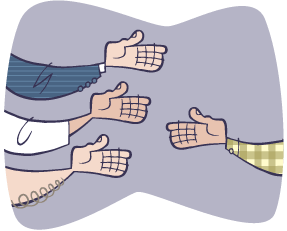
Below is an old story that makes the rounds from time to time. It’s a tale supposedly relating some kind of debt paradox or monetary flim-flam. Though no-one seems to actually explain the absurdity as it’s supposed to be self-evident, or something. Here’s the short version. (There’s an old vaudeville comedy skit that is almost the same story only with three people.)
Butcher, Baker, Tailor, and Candlestick Maker
A candlestick maker has a hundred bucks and goes to the butcher shop where we pays off $100 he owes the butcher. The butcher takes the money next door and pays off a $100 outstanding debt to the baker. The baker runs next door and makes right a hundred dollar debt to the tailor. The tailor stops the candlestick maker walking past his shop and gives him the hundred bucks he owes him, with the same money the candlestick maker used to pay off the butcher.
So, the candlestick maker gets back his hundred bucks and all four have extinguished $100 in debt yet nobody has any more or less money than they began with.
That’s basically the story. I guess what we’re supposed to wonder, how can $400 in debts be wiped out with only $100 and where everyone is no richer or poorer? What was accomplished? What is wrong with the scenario?
From an accounting aspect, nothing. Each person owed and was owed $100 and so were at net zero before and are net zero after the exchanges, except the candlestick maker who was net $100 to the good before and after. All accounts balance, no problem there.
Still, doesn’t the whole thing seem like an exercise in futility? What was accomplished? Well, all the debts were extinguished, everyone’s books were cleared of both credits and debits. That’s all good. All the same, isn’t this just sort-of transferring around debt? Again, what was really accomplished? The entire process seems rather pointless.
Or does it?
The real problem is the story didn’t begin at the beginning. It starts with a series of assumed debts while leaving out how those debts were incurred. To know what was accomplished you need to know what the debts were for. I mean, the debts didn’t come from nowhere for nothing.
For instance, the candlestick maker bought $100 worth of meat from the butcher on credit, the butcher bought $100 worth of baked goods, the baker bought $100 worth of clothes, the tailor bought $100 worth of candlesticks. When you include this in the mix the process becomes entirely sensible, there was an exchange of goods for all.
What we really have is not some kind of paradox, but a pretty straightforward story of how markets work and money circulates, with credit tossed in. If each person had just paid cash for the goods up front, you get the same result minus the delay in payment. There’s no problem at all in either case.
Thing is, you don’t need the amount of money to equal the total value of goods because the money circulates. In fact, you could add a tinker and a blacksmith to our story without adding one more dollar and the economy would still work. Well, as long as the money circulated fast enough.
On the other hand, if all the debts were just everyone borrowing money from each other with no exchange of goods or services, then the entire story would be a pointless exercise.
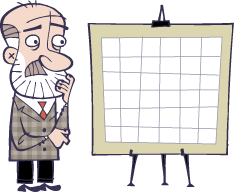


Federal Reserve policy targets inflation to be two percent with the idea that growth and inflation just naturally go hand in hand. Overlooking that inflation transfers wealth from savers to borrowers, is it true inflation means growth? Maybe not.
When we hear inflation we think rising prices. But price increases are the result of inflation, not inflation itself. Inflation has to do with the value of money. If you increase the supply of money its value goes down. Usually. For this reason some people think of inflation as a rising money supply. These folks would be confused where the money supply goes down yet prices go up. If we correctly diagnose what inflation is, the confusion vanishes.
Why do prices rise? Before we can answer that we must answer, what determines prices. The short answer, supply and demand. Demand is money, supply is goods. Prices can be derived by dividing demand in money terms by supply, or goods. The ratio of money per goods gives the price. This can be indicated as a fraction, M/G. Goods are products and services, in other words production. Put another way, prices are the ratio of money per production, M/P.
Base case: $1000/1000units = $1/unit
The price will change when the ratio changes, when the amounts on either side of the fraction change at a different rates. It’s not the amount of money or the amount of supply by themselves, it’s the ratio between the two that matters. If the money supply doubles and production doubles there’s no price increase.
Case Two: $2000/2000units = $1/unit
Change the ratio and the price changes. Which leads us to the classic definition of inflation, “more money chasing fewer goods”. Or, more demand for less supply. Notice there are two amounts involved, money and goods. Inflation happens when the ratio changes, more money, fewer goods, or both.
Inflation: $1000/1000units = $1/unit … $1200/800units = $1.50/unit
Inflation is an increase in the ratio of money per production, M+/P-. There are five ways to change the ratio of money to units that increase the price, to get inflation.
1. Money increases, production remains the same.
(M+/P)
2. Money increases more than production increases.
(M++/P+)
3. Money increases, production decreases.
(M+/P-)
4. Money remains the same, production decreases.
(M/P-)
5. Money decreases less than production decreases.
(M-/P--)

Notice on our little thumbnail graphs for each case money and production start together and money ends up higher. Just as the price of units rose as the ratio changed, the prices of goods in general rise from the same type of ratio change. Rising prices are the sign of inflation, the increase in the ratio of money to production.
Though some may suppose inflation and growth go together, there are four ways to have inflation when production either remains static or decreases. Some might also suppose to have inflation the money supply must increase, but there can be inflation where the money supply is static, case four, or decreases, case five. There can be inflation in a deleveraging environment where the money supply is shrinking.
Contrary to what some might believe, inflation does NOT always signify an expanding economy. A contracting economy CAN have inflation. To think a little inflation is good because it means growth is true in some cases and wrong in others. It’s because it is not only the amount of money or production by themselves that matter, it’s the ratio between the two.

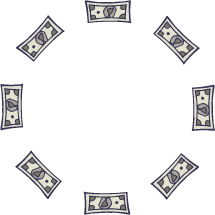

A favorite argument of some Austrians is what they call maturity mismatch. Which is banks borrow short and lend long, which would be fraud. The problem is, banks don’t borrow short, they borrow for an indefinite period that in practice is longer than their lending. The maturity mismatch is the other way around and so isn’t fraud. Well, 99.99% of the time.
While “I’ll be forever in your debt” is just a figure of speech to most, to a bank it’s a business model. That’s because in a way a bank never pays off its debts. Banks are in debt as long as they exist.
Say a bank opens with $100m of deposits. Deposits are loans to the bank. Year after year accounts grow and shrink, new accounts open, old accounts close. All the while the total deposits hover right around $100m. (Adjusted for inflation) Two hundred years after the bank’s founding deposits are still $100m and none of the original accounts or depositors exist.
In effect, the bank continually rolls over it’s debt paying off old loans of old depositors with new loans from new depositors. In aggregate the bank never pays off the $100m principle, it more-or-less transfers the ownership of its IOUs. As long as the bank can take new loans to pay old loans it can go on forever paying only interest on the perpetually rolled over debt.
Unlike people, banks are not mortal. Mortal people generally pay off the principle on loans they take; banks, corporations and governments don’t need to. Theoretically these institutions could never pay off outstanding debt so long as they can roll over their loans and make the interest payments.
This is why some folks say, “Debt doesn’t matter.” If you can repay old loans with new loans it would seem not to matter. If you simply ignore the interest paid. Ten percent interest means paying an amount equal to the principle every ten years. Or ten times the principle in a century.
Anyway, immortal institutions can and do go bust from bank runs and liquidity crunches, where old loans are called and new loans are not forthcoming. In a trice the immortal is mortal after all. Just ask Lehman Brothers about that.
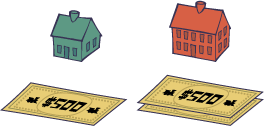
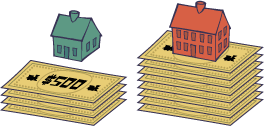
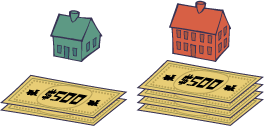
During every housing bubble eager lenders are happy to tell you how the best time to sell your house and move up is when the market is strong, the house you’re selling has increased in value, thus increasing your buying power. After all, you’re maximizing your profit and equity, right?
By the same token, people figure when the housing market is down is no time to trade up, but to hold on and sit tight. Don’t want to take a hit selling for a loss, right?
Wrong in both cases. The best time to trade up is when prices go down, and when prices rise is the worst time to trade up. Don’t buy it? You can prove it to yourself with this simple exercise using Monopoly money, houses and hotels.
Let’s say you start the game with $2,000 and no property. Houses sell for $1,000 and hotels (representing a house twice as good) go for $2,000.
Game One, Constant Prices: On your first turn you buy a house for one thousand dollars, you now have a house and one grand. On your next turn you sell the house back for the same price and now have $2,000, same as you started with. On turn three you buy a hotel for $2,000.
At the end of the game and you end up with a hotel and no money. You spent a grand total of two grand and have a hotel. It’s simple math: 2,000 - 1,000 + 1,000 - 2,000 = 0.
Game Two, Rising Prices: On turn one you buy a house for one grand leaving you with a house and one thousand dollars. At this point house values, including hotels, double across the board. Next turn you sell the house back for twice what you paid, $2,000. You now have three grand and no property. You made a $1,000 profit, you think.
On turn three you buy a hotel, but since prices are twice what they were it now costs $4,000. At the end of turn three you have a hotel, the same as above, on which you owe another $1,000. What happened to that $1,000 profit? In this game you have a hotel, but you had to spend $3,000 overall to get it. It’s simple math: 2,000 - 1,000 + 2,000 - 4,000 = -1,000.
Game Three, Falling Prices: On turn one you buy a house for one thousand bucks so you have a house and one grand. At this point house values, including hotels, fall 50% across the board. On turn two you sell the house back for half what you paid, $500. You now have $1,500 and no property. Oh no, you lost 500 big ones! On turn three you buy a hotel, but since prices are half it now sells for one grand instead of two.
At the end of turn three you have a hotel, the same hotel as in game one, plus $500 left over. You only spent a total of $1,500 for the game. Even though you lost five hundred on the first house, you’re $500 better off than in game one because the hotel is $1,000 cheaper. It’s simple math: 2,000 - 1,000 + 500 - 1,000 = 500.
If it were only your house gaining and losing value it’d be a different story. When trading houses, values are relative to the market as a whole. The simplest way to think about it, in a falling market you lose money on the house you sell, but better houses have lost more and so are more affordable. It’s a net gain. In the meantime you live in whatever house you have, and that’s the real value of a home after all.